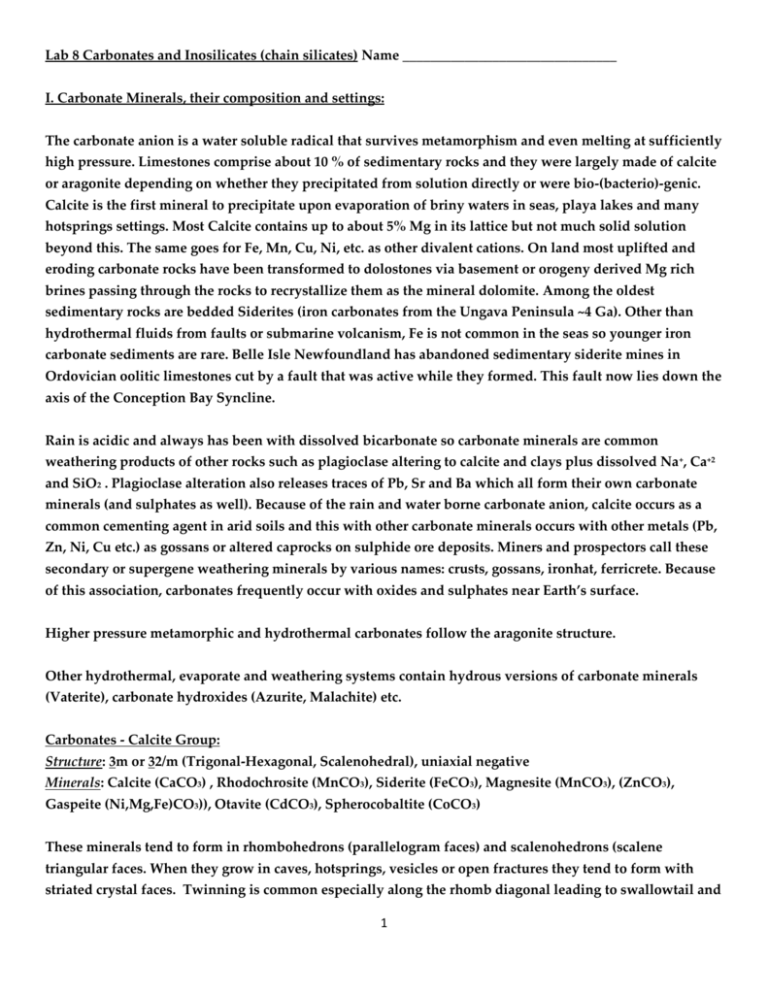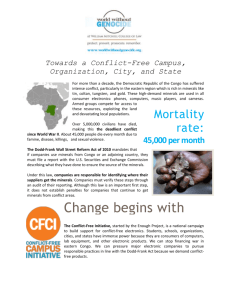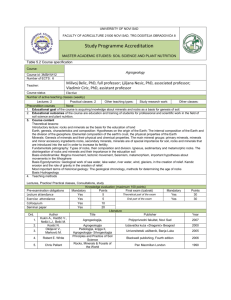Mineral Lab 8 Carbonates and Chain Silicates
advertisement

Lab 8 Carbonates and Inosilicates (chain silicates) Name _______________________________ I. Carbonate Minerals, their composition and settings: The carbonate anion is a water soluble radical that survives metamorphism and even melting at sufficiently high pressure. Limestones comprise about 10 % of sedimentary rocks and they were largely made of calcite or aragonite depending on whether they precipitated from solution directly or were bio-(bacterio)-genic. Calcite is the first mineral to precipitate upon evaporation of briny waters in seas, playa lakes and many hotsprings settings. Most Calcite contains up to about 5% Mg in its lattice but not much solid solution beyond this. The same goes for Fe, Mn, Cu, Ni, etc. as other divalent cations. On land most uplifted and eroding carbonate rocks have been transformed to dolostones via basement or orogeny derived Mg rich brines passing through the rocks to recrystallize them as the mineral dolomite. Among the oldest sedimentary rocks are bedded Siderites (iron carbonates from the Ungava Peninsula ~4 Ga). Other than hydrothermal fluids from faults or submarine volcanism, Fe is not common in the seas so younger iron carbonate sediments are rare. Belle Isle Newfoundland has abandoned sedimentary siderite mines in Ordovician oolitic limestones cut by a fault that was active while they formed. This fault now lies down the axis of the Conception Bay Syncline. Rain is acidic and always has been with dissolved bicarbonate so carbonate minerals are common weathering products of other rocks such as plagioclase altering to calcite and clays plus dissolved Na +, Ca+2 and SiO2 . Plagioclase alteration also releases traces of Pb, Sr and Ba which all form their own carbonate minerals (and sulphates as well). Because of the rain and water borne carbonate anion, calcite occurs as a common cementing agent in arid soils and this with other carbonate minerals occurs with other metals (Pb, Zn, Ni, Cu etc.) as gossans or altered caprocks on sulphide ore deposits. Miners and prospectors call these secondary or supergene weathering minerals by various names: crusts, gossans, ironhat, ferricrete. Because of this association, carbonates frequently occur with oxides and sulphates near Earth’s surface. Higher pressure metamorphic and hydrothermal carbonates follow the aragonite structure. Other hydrothermal, evaporate and weathering systems contain hydrous versions of carbonate minerals (Vaterite), carbonate hydroxides (Azurite, Malachite) etc. Carbonates - Calcite Group: Structure: 3m or 32/m (Trigonal-Hexagonal, Scalenohedral), uniaxial negative Minerals: Calcite (CaCO3) , Rhodochrosite (MnCO3), Siderite (FeCO3), Magnesite (MnCO3), (ZnCO3), Gaspeite (Ni,Mg,Fe)CO3)), Otavite (CdCO3), Spherocobaltite (CoCO3) These minerals tend to form in rhombohedrons (parallelogram faces) and scalenohedrons (scalene triangular faces. When they grow in caves, hotsprings, vesicles or open fractures they tend to form with striated crystal faces. Twinning is common especially along the rhomb diagonal leading to swallowtail and 1 cockscomb habits. Calcite is extensively mined as an industrial mineral and roasted in rotary kilns to produce lime for Portland cement. The simple compositions and ready dissolution in acid makes the related simple rhomb carbonates ideal ore minerals for Mg, Zn etc. This acidic dissolution releases CO2 and has a significant Greenhouse gas and carbon footprint environmentally. Ore deposits with these minerals are favoured for the mining industry because the carbonate is a natural buffer or remediation for acid rock drainage from the weathering of pyrite and other metal sulfides. Examine pure mineral specimens or rock occurrences of these minerals then do the following exercises. 1. Fill out the table with your observations and facts from Klein and Dutrow or Websites for the physical properties. H-Sym denoted Hermann-Mauguin Symmetry or Bravais lattice type, Cleavage angles, XL (Crystal) Characteristics denotes individual face appearance e.g. curved, flat, triangular, rhombs, twinned, striated, colour zoned etc., Occurrence: large single crystals, massive with minerals X, Y, Z in a (plutonic, skarn, weathered gossan etc.). (40 points) Mineral Formula H-Sym Cleavage ⁄ °’s XLCharacteristics ______ Occurrence ___________ Calcite Magnesite Siderite Rhodochrosite Smithsonite Gaspeite Otavite Spherocobaltite 2. Examine the 3 coloured calcite crytals trying not to scar up the crystal faces too much, rather testing corners or edges. Fill out the table describing the variation and cause of their colouration. Colour of Calcite Cleavage ⁄ °’s (16pts) XLCharacteristics ______ Element? Cause of Colour Variation ____ Turbid White Blue Green Salmon 2 3. What are the industrial uses and environmental issues associated with the mining, production and treatment/beneficiation of calcite and magnesite? (6 points) Carbonates - Dolomite Group: Structure: 3 (Trigonal-Rhombohedral), uniaxial negative Minerals: Dolomite Ca(Mg,Fe)(CO3)2 , Kutnohorite Ca(Mn, Mg, Fe)(CO3)2 , Ankerite Ca(Fe, Mg)(CO3)2 , Minrecordite CaZn(CO3)2 These minerals all tend to form in rhombohedrons (parallelogram faces) and scalenohedrons (scalene triangular faces. The Ca+2 ion is sufficiently larger than the other divalent metal cations, that unlike the Calcite structure there are smaller cations that require a different site. Notice that there is rather complete substitution for the smaller M2 ion among Mg, Fe and Mn such that the 1st three minerals are effectively a complete solid solution series. This structure tends to form replacively after calcite in low temperature geochemical cements, and hydrothermally in hotsprings, and metamorphically in marbles and skarns with complex brine compositions. In reality, one metal or another tends to dominate the water composition in any setting so that they are treated as separate minerals. When these minerals form metamorphically under a stress field and higher temperatures than the uplifter eroded setting as we find them, the crystals are often bent and can lock in stresses. Care needs to be taken in mining, blasting or quarrying such rocks as they can fail catastrophically with rock-bursts or contribute to mine collapse. Drilling such rocks with high pressure fluids can equalize and unlock stresses causing small to medium sized earthquakes. 4. Plot pure end member compositions for Calcite, Magnesite, Dolomite, Siderite and Ankerite in the Ca-MgFe triangle. Sketch in balloons for the natural fields of real carbonate mineral occurrences in limestones and hotsprings deposits assuming 5 atomic or mol% is the limit of substitution for Calcite, magnesite and siderite. For Dolomite and Ankerite there is a complete solid solution series. The implications for this system is that real rock compositions inside the triangle tend to be composed of 2 or more combinations of end member minerals rather than a single mixed phase or all possible minerals in one rock. It also means that there are Calcite-Dolomite or Calcite-Ankerite rocks and Dolomite-Magnesite or Ankerite-Siderite rocks, but not equilibrium Calcite-Magnesite-Siderite rocks as the lesser phase would react to form some Dolomite-Ankerite. What minerals would be present in a rock having Ca:Mg:Fe of a) 78:16:6 versus b) 25:5:70. Plot a and b on the triangle to solve this problem. Notice in the Calcite group that Mn+2 , Ni+2 can also substitute in the calcite structure at low levels (</= 5%) or form their own minerals. If Mn replaces Mg in the previous triangle the new corner and edge phases are Rhodochrosite and Kutnahorite with similar solid solution behaviour against Fe+2 as did the Mg+2 analogs. These compositional triangles are not only useful projections for visualizing mineral compositions in rocks, but also phase diagrams governing coexistence and stability fields for natural rock and ore systems. 3 Ca-Mg-Fe Carbonate Minerals: Name _________________________________ Aragonite Group: Structure: Orthorhombic-dipyramidal, mmm, 2/m 2/m 2/m), Biaxial negative Aragonite (CaCO3), Cerussite (PbCO3), Strontianite (SrCO3), Witherite (BaCO3), Thermonatrite (Na2CO3 – H2O) The Aragonite group of orthorhombic carbonates tend to make di-pyramidal crystals like well-formed olivine does. Compared to the preceding trigonal-rhombohedral structures these tend to form at higher pressure where the greater pressure favours the distorted 9 fold coordination for Ca+2 and the other large cations. Aragonite also forms biogenically and is metastable. Molluscs, corals and other invertebrates have taken advantage of the lower solubility and increased hardness of this denser structure to withstand abrasion, breaking, chomping and dissolution in acidic waters ever since the Cambrian explosion of hardbodied animal life. Strontianite is the significant ore mineral of strontium while the other minerals in this group occur along with other more abundant ore minerals, they are rarely mined alone. That said, pure deposits of any mineral can generate some economic interest if abundant enough. The Mississippian St. Genevieve Limestone in southern Indiana has high purity low-Mg calcite and where the limestone is a less permeable micrite, it has often escaped dolomitization. Like most limestone, it is quarried as a source of lime for cement. Some layers of chert, veins of calcite or dolomite and open geodes occur in the quarries. The geodes contain crystals of: fluorite, barite, greigite, sphalerite, millerite, and vaesite. If they are recognized during loading, they are rejected and set aside. Otherwise they constitute variable impurity load of: Si, Mg, F, Ba, Fe, Zn & Ni in the lime derived from those sites. Ore ≠ 1 mineral! 4 Azurite (Carbonate-Hydroxide-Hydrate) “Group”: Structure: Various Azurite Cu3(CO3)2(OH)2, Malachite Cu2CO3(OH)2, Monohydrocalcite (CaCO3-H2O), Hydrocerussite (Pb3(CO3)2(OH)2), Dundasite (PbAl2(CO3)2(OH)4-H2O) These minerals are lumped together here for convenience sake and tend to occur in gossans, ferricretes and duricrusts on weathered ore deposits below. Due to the low metals content none of these are favoured ore minerals in their own right but they are indicators of the characteristic elements (Cu, Pb, etc.) they contain in sulphide ore deposits at depth. Hydroxide and hydrated carbonate and bicarbonate (HCO3 -) minerals are characteristic to near-surface, low-temperature weathering environments. Many additional complex metal carbonates (Na-Ca, Ca-Cu, etc.) and carbonate chloride minerals exist and are found in continental salars and playa lake evaporate deposits where they co-exist with chloride salts, sulphates and borates. 5. Fill out the table for “Other carbonates” with your observations on our specimens and facts from Klein and Dutrow or Websites for the physical properties. H-Sym denoted Hermann-Mauguin Symmetry or Bravais lattice type, Cleavage angles, Associated minerals refers to the specimens in lab or in general as a look up thing for other assemblages, Occurrence: igneous plutonic, regional metamorphic, hydrothermal, sedimentary etc. as above. (28 points) Mineral Formula System & H-Sym Optics U,B+/- Cleavage°’s XL Form_____ Associated minerals Occurrence for lab specimens Dolomite (use samples) Aragonite Azurite Malachite Part II Inosilicates - Chain Silicates: Pyroxenes, Pyroxenoids and Amphiboles: Mineral Hand specimens Augite, Enstatite, Diopside, Aegerine or Acmite, Wollastonite, Ferrosilite (in with slag in green/blue box), Jadeite, Rhodonite, Hornblende, Actinolite, Tremolite Inosilicates mostly occur in 1 unit chains with the stoichometry (SiO3)-2 and 2 unit chains with the stoichiometry (Si8O22 )-12(OH)-)2 . Both are typically held together by one or more of the common cations 5 Ca+2 , Mg+2 , or Fe+2 but they also substitute Al+3 in both the tetrahedral chain sites (at higher pressure) or octahedral sites in aluminous assemblages. The other divalent cations are substituted at ppm to % levels for the major element cations as are some of the mono and trivalent cations mostly in octahedral sites. The alteration of primary magmatic pyroxenes or amphiboles by hydrothermal or metamorphic waters releases most of the metals found in skarn and massive sulphide deposits (Cu, Zn, Co, Mn etc.). There are rare 3, 4, 5, 6, 7 and mixed combinations of chains (2-3, 2-4 etc.) to make other unusual inosilicates (Jimthompsonite with a 2 chain repeat). Many amphiboles and hydrated rims or zones in igneous pyroxenes actually contain regions of more conjugated chains so they aren’t a perfect fit to either the one or 2 chain stoichiometries. Pyroxenes in deuterically altered plutonic and hydrothermally altered metamorphic settings often have shimmery regions marking the beginning of silicification and link up of chains containing some of these multiple chain inosilicate material. In unusual alkaline compositions Ti+4 can substitute in silicates or even find a site all its own as in aenigmatite. Pyroxenes tend to form blocky prisms whose length is parallel to the single pyroxene chains. Several prism faces may form but these include the 2 preferred cleavage directions. Augite and enstatite tend to cleave at 87° and 93° and form 8 sided prisms where the cleavages are parallel to the corner faces. Wollastonite is a pyroxenoid with curving single chains to accommodate all large Ca ions. This changes the characteristic cleavage angles to 77° and 103°. Crystals which show the prism cross section show symmetric extinction. Monoclinic pyroxenes always have a small z angle C (inclined extinction) while orthorhombic pyroxenes always have extinction parallel to the cleavage traces. Monoclinic pyroxenes have high 2-3 order maximum birefringence colours while orthopyroxenes have low birefringence below 1st red or yellow. Titaniferous augite in alkali oliving basalts has a faint pinkish or purplish brown pleochroism in plain polarized light. Chrome-diopside in peridotites is intense Christmas tree green. Hypersthene (Mg>Fe orthopyroxene) in silica saturated igneous rocks displays faint pink-green pastel pleochroism. Jadeite is characteristically faint jade green in colouration but may be white or shades of brown. Spodumene may be faintly pinkpurplish in colouration. Rhodonite is characteristically a bright pink or reddish colour typical of minerals made from or containing significant manganous (Mn2+) ions. Volumetrically after the neso and tectosilicates, the inosilicates comprise the most abundant minerals in the upper mantle and crust. The ocean crust is ~ half pyroxenes (augite, enstatite), lower continental crust is ~ 40% pyroxenes (diopside, hypersthenes) and amphiboles (hornblende, edenite, actinolite) and the upper mantle is ~20% pyroxenes (Cr-diopside and enstatite) and amphiboles (pargasite, hornblende, barkievikite). Without amphiboles in lower continental crust or pyroxenes and amphiboles in the asthenospheric mantle neither region would melt as readily nor produce as many magmas as such shallow cool levels. Volcanic rocks with sufficient K and water content characteristically have phenocrysts of brown hornblende. Pegmatites contain common hornblende but may also carry exotic chain silicates like spodumene (Li-pyroxene) which is mined as a source for the element Li. Inosilicates are dominant components in medium to high grade regional metamorphic rock from continental shields including greenstones, amphibolites, pyroxenites and charnokites (pyroxene gneisses). Meta marls (dirty limestones) abound in calcium rich amphiboles (tremolite and actinolite) and pyroxenes (diopside, wollastonite a 6 triclinic pyroxenoid). Metamorphosed Precambrian iron formations characteristically carry Fe-rich amphiboles like (grunerite and cummingtonite). Subducted slabs vary from half to ~80% inosilicates where they are dominant components of blueschists (glaucophane, riebeckite, arfvedsonite amphiboles) and eclogites (jadeite pyroxene). Inosilicates also are essential in most calc-silicate skarns. In volcanic rocks they make prismatic or bladed phenocrysts. In alkali rich within-plate and hotspot volcanic and their intrusive equivalents (comendite, pantellerite, peralkaline trachyte, nepheline syenite, alkali granite etc.) Na-Fe pyroxenes like aegerine, acmite and sodic ferro-hedenbergite are essential early phenocrysts. Late, near solidus, intergrowths of alkali amphiboles (riebeckite, arfvedsonite) and alkali-titanium-silicates (astrophyllite, aenigmatite, tuhualite, rosenbuschite and kochite) give these rocks there characteristic sparkly, spotted and colourful character. Amphiboles like pyroxenes come in orthorhombic and monoclinic forms. All exhibit 6 sided prisms with the 2 slant sides also forming the 56°/124° cleavages. They tend to form blades in foliated metamorphic rocks, euhedra as phenocrysts in igneous rocks and intergrown felted zones of 2-3 amphiboles in the groundmass of peralkaline lavas. Needles and fibrous forms are hazardous (lung diseases) due to the splintery tenacity. The ortho-amphiboles have parallel extinction and the monoclinic forms have symmetric extinction in prismatic section and inclined extinction cut along the prism axis. They are invariably all pleochroic especially when they contain iron due to different iron proportions and optical absorption parallel to and across the chain directions. In plutonic rocks pyroxenes can occur as well formed cumulate phase minerals (early settled phenocrysts) or later intercumulus infillings. Augite can form oikocrysts enveloping early well formed plagioclase and causing ophitic texture in gabbros. Hornblende often follows pyroxene in crystallization upon cooling and makes overgrowths and reaction rims called uralite (Ural Mtn’s). Hornblende in regional metamorphic rocks can overgrow earlier phases as net or sieve like poikiloblasts. Needle and blade like amphiboles like crocidolite (blue asbestos) were used as a chrysotile asbestos substitute but later were found to cause a particularly nasty form of cancer (mesothelioma). Tiger’s eye is a mixture of needles of quartz, limonite and fibrous riebeckite valued for its chatoyancy but beware if cutting or polishing this material it is the same amphibole as crocidolite. Wollastonite when large and well formed has also been used as an industrial insulation but again has been disused due to lung disease from exposure. High temperature Mg rich pyroxenes, like olivine can be used as a refractory for lining crucibles and in high temperature smelting and furnace applications. Pure ferrosilite (FeSiO3) does not occur in nature but can be found in furnace slag, clinker from burned out coal seams and in Fe-silicate mine slag where smelting of base metal ores floated off iron silicate slag on a denser molten metal of Cu, Ni etc. 6. Fill out the table for pyroxenes and pyroxenoids below by describing our lab specimens and looking up some of their inherent characteristics. Occurrence is the same as geological setting or environment of formation. 7 Pyroxene / Pyroxenoid Augite Formula System & H-Sym Optics U,B+/- Cleavage°’s XL Form Associated minerals Occurrence for lab specimens Diopside Aegerine Enstatite Ferrosilite Rhodonite Spodumene Jadeite 7. Fill out the table for amphiboles below as for the pyroxenes above. Amphibole Formula System & H-Sym Optics U,B+/- Cleavage°’s XL Form Associated minerals Occurrence for lab specimens Hornblende Riebeckite Crocidolite (see Tiger’s eye) Tremolite Actinolite Nephrite 8. What the common physical property of crocidolite (blue asbestos) and long fibre crysotile asbestos that causes them to useful to industry as insulation or a firewall? Explain whether it is the same property or something else which causes these same 2 minerals to be harmful to human health. Suppose you were to look at other minerals as potential replacements for these important industrial minerals. What properties would you consider as “on the list” versus “off the list” before screening the other 4000 some minerals? (6 points). 9. Explain the similarities and differences between jadeite and nephrite for useage as semi-precious gems and green rock types for carving and sculpting. Is there any advantage, significant difference or preference for one or the other? Be sure to include: structure, at least 2 relevant physical properties, and geological setting. (6 points) 8 III. Minerals to describe in rock samples: Note 3 or more observations concerning the size, shape, texture, abundance, colour, lustre, density, hardness and association for each of the following minerals in the rock specimens below. I have tried to put a guiding question or piece of background so that you can make a simple observation or 2 and comment on the big picture issue for rocks like each one. Put your observations and inference or a labelled sketch in each space provided to indicate how the underlined mineral occurs in that specific rock. 10.) Sooke Gabbro (Norite = 2 pyroxene gabbro) with Enstatite/hypersthene orthopyroxene and augite/diopside clinopyroxene together with calcic plagioclase (labradorite or bytownite) see rounded cobble or roughly broke specimen from our collection. Are these pyroxenes cumulus or intercumulus phases? What do they contribute to the fabric or structure of this plutonic rock and what can you infer from it about their environment at the time of crystallization? (3 points) 11.) Amphibolite (Greenstone metamorphosed volcanic rock with black layers of hornblende +/- biotite, green epidote and white layers of feldspar and quartz). Often these greenstone facies amphiboles lend a green colour along with pure low-temperature albite, chlorite and epidote that give the rock its facies name. These come from the Archean Snow Lake greenstone belt in northern Manitoba by Flin Flon. Before they got accreted to what was to become North America, 3.2-2.6 Ga, they were part of a convergent margin volcanic arc. What textural and compositional evidence do they give for the regional metamorphic setting rather than the primary volcanic protolith they were derived from? (3 points) 12.) Blueschist (Glaucophane/riebeckite and arfvedsonite +/- quartz, epidote, paragonite, pyrite). These are subduction metamorphosed seafloor basalt or gabbro that have seen pressure equivalent to 100 km depth but are well below 400°C. Not only do they contain hydrous minerals like blue-green-grey soda-iron amphiboles, but also often contain open vugs or cavities lined with drusy crystals presumably indicating the presence of free fluid during metamorphism. Describe the density, textures and fabrics of the amphiboles in this rock and discuss how they pertain to the subduction zone environment they formed in. 9 13.) Layered dolo-arenite and lime micrite Paleozoic Buttle Lake Limestone (Mt. Mark Fomation, Nanoose, Vancouver Island). Marine carbonate rocks precipitate as calcite or aragonite limestones, yet most are found eroded on land partially or completely replaced as dolostones. This is termed the dolomite problem in considering where all the Mg+2 ions came from to pervasively replace half of the Ca+2 in the rock. Here on Vancouver Island, the Buttle Lake formation occurs adjacent to both older Sicker volcanic and younger Karmutsen pillow basalts and breccias. Regardless of whether an adjacent formation or evaporating brines through the limy sediments on a tropical coast supplied the Mg+2 ions, notice here that the coraser grained and formerly most permeable layers are the ones that became dolomitized. Describe how this affected the modern weathering and appearance of this rock? 14. White hydrothermal dolomite in sphalerite skarn deposit from Daniel’s Harbour (Great Northern Peninsula, Newfoundland). This mine produced 7 MMT that ran 7.8% zinc, mostly from these colloform crystals in this skarn. This inflated a primary grey micrite-limestone of Middle Ordovician (Richmondian) age of which a few inclusions remain. The introduced hydrothermal minerals are white dolomite and sphalerite (brown blende). Compare the acid reactions of streaks for the 3 minerals (dolomite, sphalerite and calcite host rock) and describe this. It is a typical Mississippi-Valley-Type deposit, here a Zn rich type rather than Pb-Zn-Ag and fluorite as can occur more generally in this type setting. The world mode for those is ~Zn/Pb = 4 and Zn is usually more than equal to the Pb. These basal Paleozoic limestones rest nonconformably or in fault contact on igneous Ophiolite crust of the Iapetus Ocean. Consider the original stratigraphic position just above mafic (pyroxene bearing) basement and the tropical marine setting. Where is a likely source for Zn and Mg in this deposit? Comment on the likelihood of expected environmental damage or lack thereof in tailings from this mine considering what the ore is made up of? (6 points) 15) Malachite-azurite-limonite gossan (typical of arid cordilleran settings over Cu sulphide deposits) or Malachite-Albite skarn (Triassic, Ajax mine, Kamloops district, B.C.). Both of these specimens are supergene copper ore’s that are too low grade to bother mining. They indirectly point to other richer Cu sulphide minerals nearby. Limonite is more often mined than the Cu carbonate hydroxide minerals. Azurite and malachite are only “mined” on a small scale as semi-precious gems and only if they are particularly beautiful and easily separated. Describe the composition of these minerals and their habit, appearance and textural evidence that these are supergene showings. (3 points) 10 16) Smithsonite stockwork gossan from Howard’s Pass Yukon Pb-Zn deposit hosted in The Road River Group, Duo Lake Formation of Middle Ordovician muddy carbonates of the Selwyn Basin (Ordovician Limestones with Pb-Zn sulphides and gossans). This was a Limestone hosted Mississippi Valley type (Galena Sphalerite) deposit. Emplaced in a basin on the westernmost edge of ancestral north America against the Tintina Fault. Sphalerite, due to its polyhedral Zn voids is more electrically conductive than other sulphides and like pyrite tends to dissolve and weather faster than its associated base metal sulfides. While some of the primary galena of the ore deposit remains, subsequent fluids have attacked the sphalerite reducing it entirely to smithsonite here. Many ore deposits have been complicated by their own mineralogy and faulted setting that permits later alteration or remineralization that really complicates the textures of what we find or get to mine. Be sure to note and describe the replacive sedimentary skarn texture of the galena and how you can tell the smithsonite is secondary due to its texture. Note any associated minerals. (3 points) 17.) Jade specimens from BC. These hand specimens come from diverse “jade” occurrences along terrane bounding NW-trending faults in the interior of B.C. Typically these occur as faulted blocks on the edge of accreted oceanic crustal fragments. It all originates from hydrous metamorphism of mafic or ultramafic rocks often in a retrograde setting along the fault in the current upper crustal setting. The jade is often discontinuous and limited to small bodies in the fault zone or along one edge. Here glaciations as redistributed these so boulder prospecting is often the only context Jade ever has. Try and figure out which minerals and textures are present in our specimens. (3 points) 18.) Rossland Wollastonite Skarn occurs in pericratonic dirty limestones of the Kootenay Terrane associated with a high temperature, dry, contact metamorphic aureole of Jurassic monzonite and later the Eocene Coryell syenite alkaline pluton. Lower temperature, more CO2 rich metasomatism favours carbonates and causes other plutonic components to invade the host rock. Here, millimeter to decimeter sized fan shaped aggregates of wollastonite comprise half or more of the rock over intersections of several meters to a few tens of meters peripheral to the pluton. The deposit constitutes mineable quantities and purity of industrial wollastonite. Generally Ca rich pyroxenes (diopside), amphiboles (tremolite) and garnets (grossularite, andradite) occur along with wollastonite. Epidote group minerals may also be present along with hornblende and chlorite where Mg is present in sufficient quantities. Skarns are usually of interest for other metals that coexist: W, Cu, Au, Ag, Bi, Zn etc, the samples here mainly contain silicates. This is 11 additional confirmation for dry baking rather than infusion of the sediments by magmatic fluids. Describe the textures and 2 main minerals in this skarn and explain how the wollastonite can be identified. (3 points) 19.) Rhodonite Deposit – North Side of Cowichan Lake,Vancouver Island. Manganese deposits occur in the lower cherty beds of the Devonian Sicker Formation marine sediments as lens shaped bodies parallel to the bedding. The rhodonite bearing portion of the cherty Sicker sediments is cut by Jurassic intrusions and overlain by an angular unconformity capped by unmetamorphosed Upper Cretaceous sedimentary rocks. They are commonly in chert associated with jasper. The main manganese minerals are rhodonite, spessartite, an unidentified yellow manganese silicate, and small amounts of rhodochrosite. Residual manganese oxides and hydroxides coat the surfaces of the deposits due to leaching and oxidation of Mn. The rhodonite commonly crosscuts or replaces chert suggesting that the deposits are of replacement origin. Other features such as their bedded appearance and the fact that they occur, at about the same horizon In the Sicker sediments indicate a sedimentary origin. The Sicker is cut by granodiorite of the Middle Jurassic Island Intrusions Theoretical considerations support the view that the original Mn and Silica deposits are sedimentary and suggest that the replacement features were formed by metamorphism. This is a noted semiprecious gem occurrence and were it not for more abundant jade, it might have been the provincial mineral. Mn deposits are noted in low geothermal gradients of fore-arc settings. Hill 60 here and related showings of rhodonite in the Cowichan Valley does occur in both a Devonian and a Jurassic Arc setting for the rocks that host it. It currently occurs over a younger subduction zone (Late Tertiary-Recent). The lack of related mineralization in anything post Sicker (Devonian) suggests it is a Paleozoic age deposit and not significantly influenced by younger events. Without scratching or marring the cut slab, identify the minerals present and describe how they can be distinguished. (3 points) IV. Carbonates and Inosilicates in Thin Section: Describe the carbonate and chain silicate minerals for their dominant and most easily observed optical properties (relief, cleavage, alteration, colour, pleochroism, birefringence, associated minerals etc. Make a sketch and 2-3 observations per mineral or slide. Lone minerals are from white box and have simple numbers: (Calcite-10, Aragonite, Dolomite-14), Augite-6, Diopside-13, Enstatite-15, Hornblende-19. Use thin sections of Rock Samples for other minerals: Marbles (calcite & dolomite from Metamorphic in section box), Carbonatite (Igneous Pre-Jurassic Siderite-7320), Peridotite from Castle Rock #_____ for Cr-Diopside and Enstatite, Mg-rich Green Hornblende from the Snow Lake (Flin-Flon) Greenstone belt either 9661A-7521-d or 957PA-020-1-1, Riebeckite +/- Aegerine from 44E-7304 Mississippian Alkali Granite Massachusetts, Riebeckite in Rainbow Range Trachyte MM107-4812 05, Riebeckite in French Range Blueschist MM196-07-6b, 7329 Precambrian Ontario Gabbro-norite Enstatite, 7330 Precambrian Duluth Gabbro Augite, 7327 Triassic Nevada hornblende andesite Hornblende (50 points) Mineral name Thin #____________ Rock type Distinctive Optical Properties_______________________ 13









